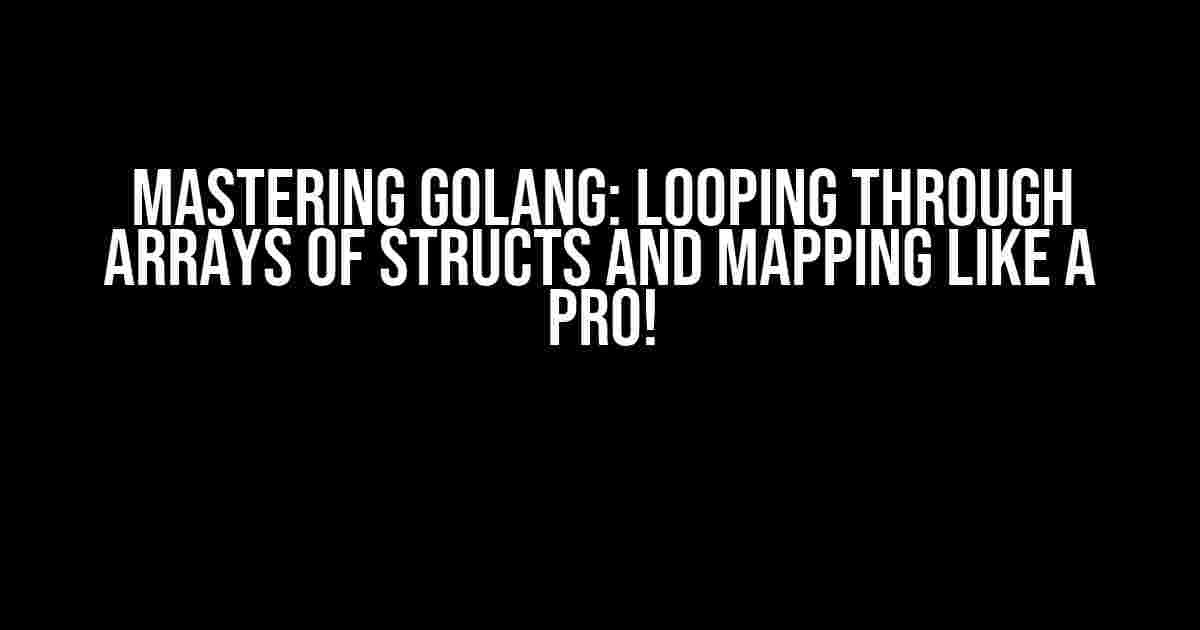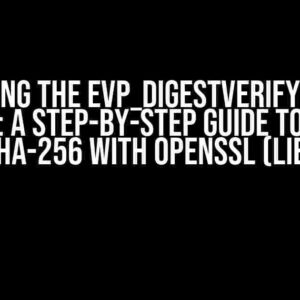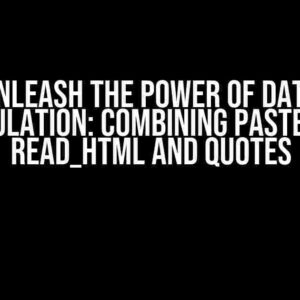Are you tired of scratching your head, trying to figure out how to efficiently loop through arrays of structs in GoLang? Do you wish there was a way to map through your data with ease? Well, buckle up, friend, because today we’re going to dive into the world of GoLang and explore the best practices for looping through arrays of structs and mapping like a pro!
- What is an Array of Structs in GoLang?
- Why Do We Need to Loop Through Arrays of Structs?
- The For Loop: The Simplest Way to Loop Through an Array of Structs
- The Range-Based For Loop: A More Elegant Approach
- Mapping Through an Array of Structs: The Power of Higher-Order Functions
- When to Use Mapping and When to Use Looping
- Conclusion: Mastering the Art of Looping and Mapping in GoLang
What is an Array of Structs in GoLang?
Before we dive into the nitty-gritty, let’s take a step back and understand what an array of structs is in GoLang. In GoLang, a struct is a collection of fields, where each field represents a value. An array of structs, on the other hand, is a collection of structs. Think of it as a slice of pizzas, where each pizza is a struct with its own toppings, crust, and sauce!
type Pizza struct {
Toppings []string
Crust string
Sauce string
}
var pizzas [3]Pizza
Why Do We Need to Loop Through Arrays of Structs?
Now that we have our array of structs, why do we need to loop through it? Well, there are numerous reasons why you’d want to iterate through your data. Maybe you want to:
- Print out each pizza’s toppings and crust
- Calculate the total calorie count of all pizzas
- Filter out pizzas with a specific topping
- Sort pizzas by their crust type
The possibilities are endless, and looping through your array of structs is the key to unlocking these possibilities!
The For Loop: The Simplest Way to Loop Through an Array of Structs
The most straightforward way to loop through an array of structs is by using a for loop. It’s like riding a bike – it’s easy, it’s familiar, and it gets the job done!
for i := 0; i < len(pizzas); i++ {
fmt.Println(pizzas[i].Toppings)
fmt.Println(pizzas[i].Crust)
fmt.Println(pizzas[i].Sauce)
}
This code snippet will iterate through each pizza in the array and print out its toppings, crust, and sauce. Simple, yet effective!
The Range-Based For Loop: A More Elegant Approach
While the traditional for loop gets the job done, there’s a more elegant way to loop through an array of structs – enter the range-based for loop! This approach is like riding a unicorn – it’s magical, it’s fancy, and it makes you feel like a GoLang ninja!
for _, pizza := range pizzas {
fmt.Println(pizza.Toppings)
fmt.Println(pizza.Crust)
fmt.Println(pizza.Sauce)
}
The range-based for loop is a more concise way to iterate through your array of structs. The `_` is used to ignore the index, and the `pizza` variable takes on the value of each struct in the array. It’s like having a personal pizza assistant, efficiently serving up each pizza’s details!
Mapping Through an Array of Structs: The Power of Higher-Order Functions
Now that we’ve covered the basics of looping through an array of structs, it’s time to take it to the next level – enter the world of mapping! In GoLang, you can use higher-order functions to map through your data, transforming and manipulating it with ease.
Let’s say you want to create a new array of structs, where each pizza has its toppings converted to uppercase. You can use the `map` function to achieve this:
func upperCaseToppings(pizza Pizza) Pizza {
pizza.Toppings = strings.Map(strings.ToUpper, pizza.Toppings)
return pizza
}
func main() {
var upperCasePizzas []Pizza
for _, pizza := range pizzas {
upperCasePizzas = append(upperCasePizzas, upperCaseToppings(pizza))
}
}
This code snippet defines a `upperCaseToppings` function that takes a `Pizza` struct as an input, converts its toppings to uppercase, and returns the modified struct. The `main` function then uses this higher-order function to map through the original `pizzas` array, creating a new array of structs with uppercase toppings.
When to Use Mapping and When to Use Looping
So, when should you use mapping, and when should you use looping? Well, it ultimately depends on the problem you’re trying to solve. Here are some general guidelines:
| Scenario | Mapping | Looping |
|---|---|---|
| Transforming data | + | – |
| Filtering data | + | – |
| Iterating through data | – | + |
| Performing side effects | – | + |
In general, if you need to transform or filter your data, mapping is a great approach. If you need to iterate through your data or perform side effects, looping is the way to go!
Conclusion: Mastering the Art of Looping and Mapping in GoLang
And there you have it, folks! With this comprehensive guide, you’re now equipped to tackle even the most complex arrays of structs in GoLang. Remember, looping and mapping are powerful tools in your GoLang toolkit – use them wisely, and you’ll be cooking up a storm in no time!
So, go ahead, fire up your GoLang IDE, and start looping and mapping like a pro! If you have any questions or need further clarification, feel free to leave a comment below. Happy coding!
Bonus Tip: Don’t forget to check out GoLang’s official documentation on arrays and structs for more in-depth information. Happy learning!
Frequently Asked Question
Get ready to unravel the mysteries of GoLang and array of structs!
Can I map an array of structs in GoLang?
Ah-ha! You can’t directly map an array of structs in GoLang. Instead, you can use the `range` keyword to iterate over the array and access each struct individually. Think of it like a superhero cape that helps you swoop through the array with ease!
How do I loop through an array of structs in GoLang?
Easy peasy! You can use a `for` loop with the `range` keyword to iterate over the array of structs. The `range` keyword will give you both the index and the value of each element in the array. It’s like having a trusty sidekick that helps you tackle the loop with confidence!
What’s the difference between `range` and `map` in GoLang?
Ah, clever question! `range` is used to iterate over arrays, slices, strings, and maps, whereas `map` is a data structure in GoLang that stores key-value pairs. Think of `range` as a navigation tool and `map` as a treasure chest – they’re both useful, but serve different purposes!
Can I use `map` to iterate over an array of structs in GoLang?
Sorry to disappoint, but `map` isn’t designed for iterating over arrays of structs. You’ll need to stick with `range` or a traditional `for` loop to access each struct individually. Don’t worry, it’s still a breeze once you get the hang of it!
What’s the best way to process an array of structs in GoLang?
The best way to process an array of structs is to use a `for` loop with the `range` keyword. This approach allows you to access each struct element and its fields, making it easy to perform operations or transformations as needed. It’s like having a superpower that helps you tackle the array with ease!



